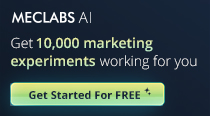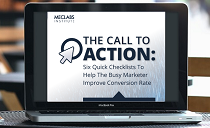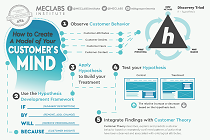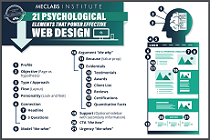April 09, 2002
How To
SUMMARY:
Every experienced marketer on this planet will tell you -- testimonials make a huge difference in sales (or opt-in registrations), especially online. This detailed article gives you specific hands-on tactics to gather and use testimonials that work, including:
a. The difference between \"solid\" versus \"lousy\" testimonials,
b. How to elicit solid testimonials with an online survey,
c. Driving traffic to your online testimonial survey,
d. Alternate ways to gather testimonials,
e. \"Fixing\" testimonials, f. Getting permission to quote someone,
g. How to use testimonials on your Web site. Note: Although this is written specifically for marketers in the content and publishing industries, other marketers will probably find real value in it as well.
|
|
Every experienced marketer on this planet will tell you:
Testimonials make a huge difference in sales, especially online.
1. Solid testimonials can create the trust a potential buyer
needs if you are an online-only company ("Look real-word people
have bought this, received it, and liked it!") or if you are a
publication that is not already a famous name brand ("Even though
you never heard of us, we are legitimate!")
2. Solid testimonials can help you "prove" your offering is
really worth the price, and increase sales conversion rates for
pricier offerings.
3. Solid testimonials can vastly improve your opt-in email
subscription rates, which may be suffering these days (even for
free newsletters) as more people become wary of giving their
email to anyone.
The key word in all three cases being "solid." Here is how you
can get them:
-> "Solid" versus "lousy" testimonials
Solid testimonials have two elements -- they sound like a real
person wrote them, and they describe useful publication benefits.
That is "real person," as in not a marketer. Two years ago when
viral (tell a friend) marketing campaigns were the hot new online
tactic, marketers discovered a fascinating fact: If you let
actual consumers write the recommendation message to their
friend, their message, no matter how lame, always outperformed a
message crafted by a marketer, no matter how expert.
This was a tough lesson for marketers who are used to controlling
messaging. Take your copy out of the forward-to-a-friend box,
and let the sender put his or her own message in instead,
because
… people can spot a faux testimonial a mile away.
Which is a problem because many of your readers and customers
will probably say, "Oh I hate to write. Write something for me,"
when you ask them for a testimonial.
In that case, just email them or call them with quick questions
based on the ideas below; and, using as many of your customer's
own words as possible, turn his or her answers into a useful
testimonial. Never just make something up out of thin air.
(Even if your customer is happy to sign their name to it, it
smells like a fake to potential customers.)
The other problem when you ask for testimonials is "It's great!"
syndrome. These are testimonials that are flat out praise
without details. "I love this publication!" "This is the best!"
"I read every issue."
While these may warm the cockles of your editor's heart, this
kind of warm-fuzzy, no-details testimonial will not do you any
good whatsoever UNLESS the person saying it is incredibly famous.
If you are publishing the eBook "101 Knitting Tips" and Martha
Stewart gave you permission to say "Great book!" then yes you are
going to abase yourself with gratitude and run that sucker as
your headline. If Bob Smith said it, it is pretty much worthless.
That does not mean Bob Smith's opinion is worthless, you have just
got to get him to word it in a different way. Specifically, you
need him to talk about how your publication has benefited him.
What has he been able to do because he has it? How has it helped
his life or career?
The more details the better. "I used the baby blanket pattern"
is nice. "I used the baby blanket pattern to make an instant
heirloom for my new grandchild in just one weekend. It was
pretty easy even though I'm not a champion knitter," is better.
-> How to elicit solid testimonials with an online survey
First of all, do not include a testimonial request in a survey
that has other questions or purposes. Generally surveys for
other purposes work best when people feel like they can speak
honestly -- which means anonymity and the freedom to say negative
things. (i.e. The opposite of what you're looking for!)
Definitely be open about the fact that you are seeking reader
quotes and stories to use in your marketing campaign. However,
instead of asking people to say how much they like your
publication, ask them how they use your publication. Examples:
"How has Trucking News helped you grow your trucking business?
Can you give any specific examples?"
"Please explain how you used your Loseweight.com site
subscription to slim down, and how much weight you lost:"
"Tell us a quick story about how you used Typist's Daily to
improve your typing:"
"If a friend asked you if they should subscribe to Brittany
Spears Report, how would you explain to them that it's
definitely worth the money?"
"How has your life changed since you started getting Healthier
Toenail Weekly?"
"What was your favorite Corvette Owner Ezine article of all-
time, and why was it so useful for you?"
Your second question should be any contact information, such as
name and city/state, which you will cite with the quote when you
use it (do not ask for contact info beyond that -- it is intrusive
and impolite to request contact data you don't need for the
quote).
You may also want to include a check box saying, "May we quote
you? Please check this box to give us permission."
Naturally, your confirmation page should feature a big "Thank
you!"
-> Driving traffic to your online testimonial survey
If you want to get your regular subscribers to give quotes, then
email them a heartfelt note asking for them to click to your
testimonial form.
You will get the best response if you send the note separate from a
regular email issue.
No, it is not appropriate to offer them a free gift or sweeps
entry because it smells a little fishy. Readers should be
honestly moved to help you (if they are not, then you have got an
editorial problem.)
Remember, you do not need that many people to answer. This is not
a survey where you require a certain number of statistically
relevant responses to base decisions on. All you need is a
handful of testimonials.
Surveys of both print and email publications have revealed that
readers are often most enthusiastic about and aware of your
product at the start of their subscription. You may want to
set up an auto-responder testimonial request to go out 60 days
after a new subscription and perhaps 24 hours after a paid
renewal (if you require regular proactive renewals) to ask folks
for quotes.
-> Alternate ways to gather testimonials
If your publication or site is brand new, you can email friends,
peers and topical experts (such as people who have written books on
the same topic, related consultants, or frequent speakers at
industry events) to ask for quotes. This practice has a long
history in the print book publishing business, where it is
standard practice to circulate a manuscript requesting jacket
blurbs before the book comes out.
If you do not already have a personal relationship with the people
you want quotes from, either reach them through a friend of a
friend ("Bob Smith said you'd be a great person to contact about
this new publication…") or start with an initial email and then
follow-up with a phone call. Often these people will end up
being story sources for you in the long run, so you are starting a
relationship that will deepen over time.
If you are an established publication and you would really, really
like a quote from a famous person in the industry who you know is
a reader, you may need to pick up the phone and call them (or
their PR department). The publisher or marketer should make this
call; not editorial.
Ego blandishments are always a great way to go, "We're running a
promotional campaign with the top 5 most important aviation
executives talking about why they subscribe to Aviation Minute,
so obviously we really want to make sure you're included."
Yes, if you get somebody famous enough, definitely also ask for a
digital version of their headshot to use as well.
-> "Fixing" testimonials
There are three situations in which you will be tempted to "fix" a
testimonial:
1. Typos -- Somebody enters a wonderful quote into your
testimonial form or emails you a great quote … but there is a
typo. Yes, you can fix it (in fact you make them look stupid if
you do not). However, do not be tempted to "clean up" imperfect
grammar too much.
Part of what makes a quote sound "real" is that it is obviously
written by a real human being -- not a marketer or editor. If
you clean it up too much, you lose the value.
2. Swearwords -- Even if you are not offended by words such as
"hell", "sucks" and "sucky", some of your readers may be. If you
decide to replace them with softer terms, be sure to get
permission first.
3. Cutting & Pasting -- Sometimes a quote would be fabulous if
you could just move the words around a little, or cut a slow
intro. (This is often especially true of unsolicited letters
from subscribers.) Go for it, but get permission for the final
quote.
-> Getting permission to quote someone
Sometimes testimonials float in the door without your even asking
for them. An emailed compliment, a remark during an interview,
praise when you meet people in person at a trade show, etc.
You cannot use these unless you have specific written permission
to do so.
Old guard publishers require that the person being quoted fax you
a signed copy of their quote. However, it is usually good enough
to keep an email on file that states in their own words that they
gave you permission to quote them for marketing purposes.
Sometimes the people giving you permission are not authorized to
do so. For example US Federal Government employees are not
allowed by law to give a testimonials referencing their
government position. Some Fortune 500 companies have similar
policies. If you have gotten a glowing quote from someone at work
who is not a super-high level executive (who supposedly would be
aware of any rules their organization has) then double-check with
their PR department that you can use it.
If you are quoting a consumer at home, it is usually best to
include their city and state (or country) so visitors know they
are "real." Sometimes customers will ask that you do not reveal
their entire name (i.e. Bob S. in Des Moines), only do this if
you have to -- it is less believable and therefore less
effective.
If you are quoting someone who has a Web site, it is generally
considered good manners to cite their entire URL even if you
do not actively hotlink to it. Often your peers and consultants
in your field will give testimonials as a method of getting the
word out about their own site. Respect that.
-> Using testimonials
If you land a killer testimonial, either from a very famous
person or one that is worded to perfection from a regular
customer, consider using that as the headline on a sales page.
Other people's words can be more powerful than the best sales
copy.
Otherwise, you have the option of putting your testimonials in a
column running next to your main sales copy, or intermingling
them with the copy, or at the bottom of the copy to give it final
umph. It is worth testing to see which design style converts more
visitors into opt-ins or buyers.
The one thing you do not want to do is hide your testimonials on a
separate page that visitors have to click on a link to get to!
Just as with all other lists, most people skim your list of
testimonials instead of reading through them one by one.
Therefore, put your sexiest testimonials in the positions the eye
notices most in a list. This would be:
Top - Best testimonial
Second - 3rd best testimonial
middle - worst testimonials
end - 2nd best testimonial
Also, if your testimonials are a variety of lengths, definitely
intersperse long ones and short ones just as you would with any
other sales copy. Too many same-sized copy blocks in a row are
not enticing to readers.
-> Next week:
We are taking a quick break from the subject of online surveys to
bring you a new Case Study about a paid newsletter publisher who
is learning lessons about online renewals.
Then in two weeks, we will bring you Surveys Part IV: Specific Tips
on Putting a Survey Online. To receive these articles, make sure
you are a subscriber at:
http://www.contentbiz.com - yes it is free.









